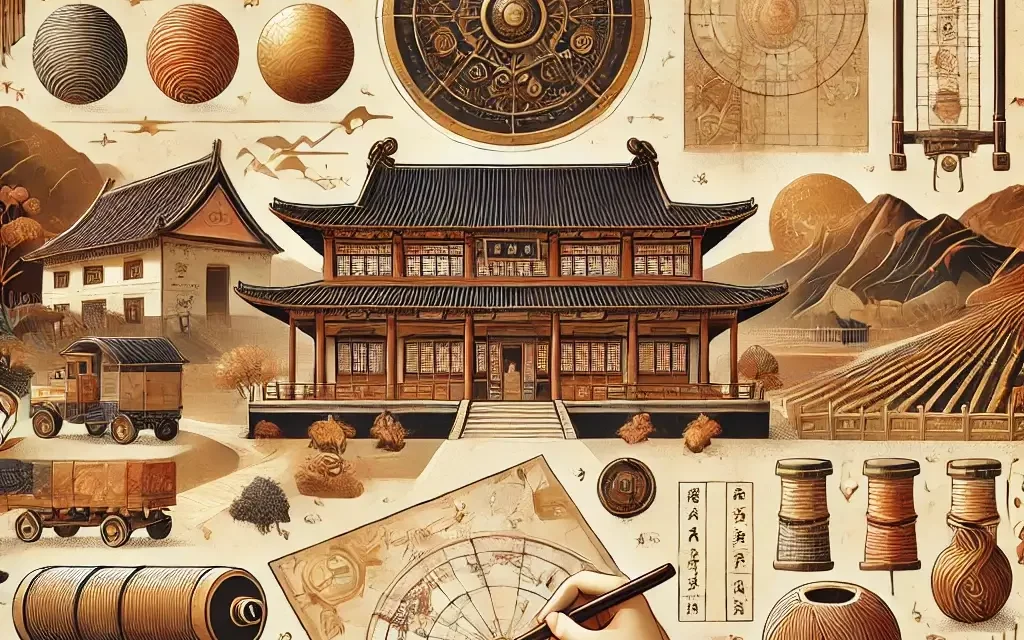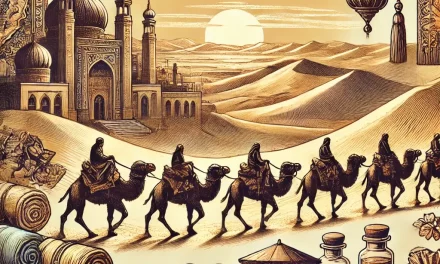The Foundation of the Han Dynasty
Following the collapse of the oppressive Qin Dynasty, the Han rose under the leadership of Emperor Gaozu, or Liu Bang. The dynasty’s emphasis on stability and governance allowed for economic recovery and cultural flourishing.
Innovations in Governance
The Han Dynasty is known for pioneering a centralized bureaucratic system that became a model for future Chinese governments. Key achievements in governance included:
- Civil Service System: The establishment of a merit-based civil service system ensured competent administration and governance.
- Confucianism as State Ideology: Emperor Wu of Han officially adopted Confucianism, promoting ethics and education as central to governance.
Technological and Scientific Achievements
The Han Dynasty contributed significantly to technological and scientific progress. Some of its key innovations include:
- Paper-Making: While earlier forms of writing materials existed, the invention of paper during the Han period revolutionized record-keeping and communication.
- Astronomy: Han astronomers developed star maps and tools for measuring celestial events, aiding both navigation and agricultural planning.
- Seismograph: Zhang Heng, a Han-era scientist, invented the first seismograph, a device to detect earthquakes, showcasing the dynasty’s engineering prowess.
Cultural Flourishing
Art and Literature
- The Han era saw the development of early Chinese poetry, historical texts, and artistic traditions.
- The historian Sima Qian wrote Records of the Grand Historian, a monumental work documenting China’s history from the mythical Yellow Emperor to the Han Dynasty.
Silk and the Silk Road
- This trade network facilitated the spread of Buddhism, advanced cultural exchange, and strengthened the Chinese economy.
Economic Advancements
- Salt and Iron Monopolies: These monopolies bolstered state revenues and funded infrastructure projects.
- Agricultural Tools: Innovations such as the iron plow and horse collar improved farming efficiency, leading to population growth and prosperity.
Military Strength and Expansion
- The Xiongnu Wars: Successful campaigns against the nomadic Xiongnu tribes ensured the safety of the Silk Road.
- Territorial Expansion: The Han expanded into Korea, Vietnam, and Central Asia, establishing a vast and diverse empire.
Medicine and Healthcare
Han medical advancements laid the groundwork for Traditional Chinese Medicine (TCM). Physicians such as Zhang Zhongjing authored seminal texts like Shang Han Lun (Treatise on Cold Damage), which remain influential.
Decline of the Han Dynasty
Despite its achievements, the Han Dynasty eventually declined due to corruption, power struggles, and peasant uprisings like the Yellow Turban Rebellion. The dynasty’s fall marked the beginning of the Three Kingdoms period.
Legacy of the Han Dynasty
The Han Dynasty’s legacy endures in modern China. Even today, the ethnic majority in China refers to themselves as the “Han people,” a testament to the dynasty’s profound influence. Its contributions to governance, technology, culture, and global trade remain benchmarks of human progress.
Conclusion
The Han Dynasty was a transformative era in Chinese history, marked by achievements that shaped not only China but the broader world. By understanding its legacy, we gain insight into the roots of modern civilization and the enduring power of innovation and culture.






Nice article
Hello there, I found your site by the use of Google while looking for a related subject, your site came up, it seems to be great. I have bookmarked it in my google bookmarks.
Thanks for the concepts you have shared here. Furthermore, I believe there are a few factors that really keep your auto insurance premium lower. One is, to take into consideration buying automobiles that are inside the good set of car insurance organizations. Cars that are expensive are definitely more at risk of being snatched. Aside from that insurance coverage is also in accordance with the value of your vehicle, so the more pricey it is, then the higher a premium you only pay.
Hello pals!
I came across a 106 great site that I think you should browse.
This platform is packed with a lot of useful information that you might find valuable.
It has everything you could possibly need, so be sure to give it a visit!
[url=https://freepctech.com/gaming/how-to-become-a-professional-league-of-legends-gamer/https://freepctech.com/gaming/how-to-become-a-professional-league-of-legends-gamer/]https://freepctech.com/gaming/how-to-become-a-professional-league-of-legends-gamer/https://freepctech.com/gaming/how-to-become-a-professional-league-of-legends-gamer/[/url]
Hello !!
I came across a 106 valuable website that I think you should browse.
This resource is packed with a lot of useful information that you might find insightful.
It has everything you could possibly need, so be sure to give it a visit!
[url=https://www.sportsoddshistory.com/nfls-forgotten-rules-rarely-used-regulations-that-could-change-a-game/]https://www.sportsoddshistory.com/nfls-forgotten-rules-rarely-used-regulations-that-could-change-a-game/[/url]
Hello everyone!
I came across a 110 fantastic tool that I think you should dive into.
This platform is packed with a lot of useful information that you might find valuable.
It has everything you could possibly need, so be sure to give it a visit!
[url=https://latestmarketplace.com/gaming-laptops-a-complete-guide-to-choosing-the-best-one/]https://latestmarketplace.com/gaming-laptops-a-complete-guide-to-choosing-the-best-one/[/url]
whoah this blog is fantastic i really like studying your articles. Keep up the great work! You know, lots of persons are hunting round for this info, you could aid them greatly.
казино кат
This is my first time pay a quick visit at here and i am really happy to read everthing at alone place.
https://raznye-raznosti.ru/
you are actually a just right webmaster. The site loading speed is incredible. It sort of feels that you’re doing any unique trick. Moreover, The contents are masterpiece. you have done a fantastic task on this topic!
google
Howdy very cool website!! Man .. Excellent .. Amazing .. I will bookmark your website and take the feeds also? I am glad to find so many helpful info right here in the put up, we’d like develop extra techniques on this regard, thank you for sharing. . . . . .
либет казино
deca dianabol test cycle
References:
https://gratisafhalen.be/author/firedchard74/
Implementing post-cycle remedy (PCT) is beneficial, as Anavar will lower endogenous testosterone production. This may be less severe in comparison with an Anadrol-only cycle; however, we now have noticed hypogonadism transpiring from Anavar-only cycles. With Out PCT, testosterone deficiency might last for a number of weeks or months. This stage should solely be attempted after successfully finishing beginner cycles and with correct monitoring to keep away from undue strain on the physique. Additionally, bear in mind post-cycle therapy is crucial for returning hormone levels to normal. For male novices, a typical Anavar dosage ranges between 20-50mg per day. Beginning with a decrease dosage, similar to 20mg, allows your physique to adapt and minimize the danger of antagonistic effects.
After all, a well-structured cycle is all about stability – long sufficient to provide impressive outcomes, but not so prolonged that it places undue stress on the body. (2) Schimrigk, Häusler, G., Blümel, P., Plöchl, E., Waldhör, T., & Frisch, H. Furthermore, if an individual has experienced gynecomastia, this is a sign that the substance is Dianabol (42). These are some of the points bodybuilders who go to our clinic face when acquiring UGL Anavar. In terms of meals selection, mostly clear meals decisions should be consumed, together with unrefined carbohydrates and unsaturated fats. Wholesome foods that aren’t high in sodium will inhibit water retention, adding to the dry and outlined look that Anavar encourages. Clenbuterol burns a significant quantity of subcutaneous fat, similar to Anavar; thus, combining these two compounds will result in significant fat loss.
Clenbuterol is a beta-2 sympathomimetic and is often used within the remedy of hypotension. It can be a bronchodilator, effectively opening the airways because of the relaxation of easy tissue. Consequently, we now have found it to be an efficient treatment for asthma victims.
In the united states, it’s considered a controlled substance, and possession without a prescription can have serious legal consequences. Utilizing performance-enhancing drugs also raises ethical considerations, because it can give you an unfair advantage in sports or competitions. Be conscious of how your selections may affect the fairness and integrity of the competitions you take part in. Whereas we understand the will to excel, it’s essential to do so in a means that aligns with your values and the regulation. Asana Restoration supports individuals who may be grappling with substance-related choices.
We have found testosterone to be cardiotoxic, although much less so than different anabolic steroids. Moreover, testosterone just isn’t particularly hepatotoxic, as it is an injectable steroid. Hepatic and cardiac health are the two primary concerns we’ve when someone is using anabolic steroids. An Anavar-only cycle is commonly practiced by novices and intermediates throughout a chopping section. An Anavar-only cycle can improve fat burning while including moderate quantities of muscle mass. Reduce dangers by strictly adhering to prescribed doses, sustaining regular health check-ups, and avoiding alcohol or different liver-stressing substances.
Mental Health Outpatient Treatment can even handle any underlying points. Absolutely—when used appropriately, Anavar for bodybuilding delivers spectacular muscle progress, strength increases, and fats loss, with a relatively low threat of harsh unwanted aspect effects. By timing your doses correctly and sticking to a smart dosage, you’ll find a way to maximize your results whereas minimizing well being dangers. Stacking completely different compounds at this degree of bodybuilding is a standard follow, nevertheless it isn’t with out its careful issues. The compatibility and correlations between different substances can remarkably affect the outcomes. The purpose while stacking during a cutting section is to combine compounds that work synergistically to maximise fats loss while preserving lean muscle mass. Anavar, or Oxandrolone, is a robust artificial anabolic steroid derived from dihydrotestosterone (DHT).
However steroids have fairly a bad reputation due to their nasty unwanted facet effects. Nevertheless, not all steroids are created in the identical way, and Anavar is taken into account a milder choice amongst them. In this cycle pattern, the Anavar dose of 20 mg/day is maintained for 8 weeks.
Relying in your bodybuilding stage, whether or not you’re beginning, sustaining, or mastering, the utilization and cycle of Anavar will differ. It’s very important to understand its specifics to ensure you’re not only getting the specified results, however you’re additionally maintaining your well being in verify. Anavar (oxandrolone) is an oral anabolic steroid created in 1962 to advertise lean muscle mass in these affected by muscle-wasting circumstances. The different major goal when formulating Anavar was to create a light drug with few side effects so ladies and youngsters could safely take it.
References:
https://www.valley.md/anavar-dosage-for-men
how to take hgh for bodybuilding
References:
How Many Hgh Injections Should I Take (https://Www.Google.Ps)
how much hgh for muscle growth
References:
wehrle
supplements like steroids
References:
do Anabolic steroids work (http://baseddate.com/@duane65g766536)
meditech steroids
References:
Steroids online (git.agusandelnorte.gov.ph)